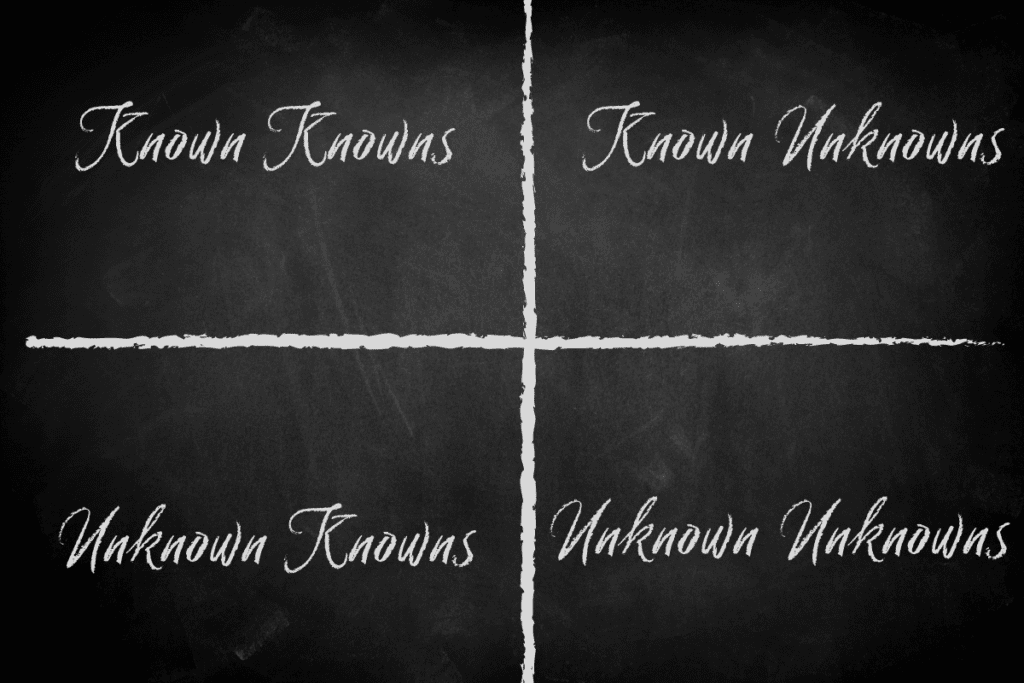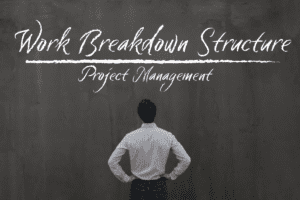Overview of the Rumsfeld Matrix: Classifications From Known-Unknown
Ever wondered about the Rumsfeld Matrix and its significance? Dive in as we unravel the concept and its applications, ensuring you grasp its essence.
The Rumsfeld Matrix, also known as the “Known Unknowns” matrix, is a tool introduced by former U.S. Secretary of Defense, Donald Rumsfeld. It categorizes information into four quadrants based on what we know and don’t know: Known Knowns, Known Unknowns, Unknown Knowns, and Unknown Unknowns. This matrix aids in risk assessment and decision-making by highlighting areas of certainty and uncertainty.
Stay with us as we delve deeper into the intricacies of the Rumsfeld Matrix, its history, and practical applications in various fields.
The Origins of the Rumsfeld Matrix
The framework gained prominence during a press briefing in 2002 when Donald Rumsfeld, the then U.S. Secretary of Defense, used it to explain the challenges of evidence gathering.
In response to questions about the lack of evidence concerning weapons of mass destruction in Iraq, Rumsfeld stated, “There are known knowns; there are things we know that we know. There are known unknowns; that is to say, there are things that we now know we don’t know. But there are also unknown unknowns; there are things we do not know we don’t know.” This statement triggered further exploration of the classification of knowledge and uncertainty, leading to the development of the Rumsfeld Matrix.
The matrix’s beauty lies in its simplicity, breaking down complex scenarios into understandable segments. By categorizing information based on our awareness and ignorance, it provides a clear picture of potential risks and opportunities.
Read on with us as we explore the intricacies of the Rumsfeld Matrix, its applications in various fields, and its potential to transform the way we approach risk and uncertainty. Whether you’re a seasoned professional or just curious about the concept, there’s something here for everyone. Join us on this enlightening journey!
The Four Quadrants Explained
Paragraph:
- Known Knowns: These are things we know that we know. They represent clear certainties and are often the basis for our decisions.
- Known Unknowns: These represent areas where we know there’s a gap in our knowledge. It’s an acknowledgment of things we’re aware we don’t understand.
- Unknown Knowns: These are things we know but are unaware that we know them. Often, these are subconscious beliefs or ingrained knowledge that influence our decisions without our overt realization.
- Unknown Unknowns: These are the most challenging as they represent areas we don’t even know we’re ignorant about. They are unforeseen challenges or opportunities that can catch us off guard.
Practical Applications of the Rumsfeld Matrix
Beyond its initial context in defense and intelligence, the Rumsfeld Matrix has found applications in business, project management, and personal development. Companies use it for risk assessment, identifying potential market opportunities, and strategic planning. By understanding what they know and acknowledging what they don’t, organizations can navigate uncertainties more effectively.
The Matrix in Everyday Decision Making
On a personal level, the Rumsfeld Matrix can be a powerful tool for introspection and decision-making. By categorizing our knowledge and uncertainties, we can make more informed choices, whether it’s in our careers, personal projects, or daily life challenges.
Can the “Known Unknowns” Matrix be Used in Project Risk Management?
The Rumsfeld Matrix is helpful in project risk management. It allows individuals or organizations to categorize and evaluate different types of risks or uncertainties they may face into the four quadrants. Strategies can be deployed to manage or mitigate the identified risks by category.
1. Known Knowns: These are risks or uncertainties that are well-known and understood. They are familiar and can be dealt with using established processes or strategies. Identifying and managing these risks is relatively straightforward.
2. Known Unknowns: These are risks or uncertainties that are recognized to exist, but the exact details or potential impact may be uncertain. These risks require further investigation and analysis to gather more information. Strategies for managing these risks typically involve conducting research, seeking expert advice, and implementing contingency plans.
3. Unknown Knowns: These are risks or uncertainties that are commonly overlooked or not fully recognized. Often, these risks reside in institutional knowledge held by long-term employees but aren’t documented or widely shared. Over time, as employees leave or as the organization grows and evolves, this knowledge can get buried or lost. Without proper identification and communication, these risks can suddenly emerge, catching an organization off-guard. It’s essential to have mechanisms in place, like regular knowledge sharing sessions or comprehensive documentation practices. Establishing set communication between departments to unearth and address these hidden risks can help stave off risks in this section of the quadrant.
4. Unknown Unknowns: These are risks or uncertainties that are completely unknown and unpredictable. They are unforeseen risks that can catch individuals or organizations off guard. These risks are the most challenging to manage since they are not even considered until they occur. Mitigating unknown unknowns involves implementing robust risk management practices, fostering a culture of preparedness, and staying vigilant to emerging threats.
Can Risks Move from Known Knowns to Unknown Unknowns in the Quadrant?
Yes! Risks can and often do move between the quadrants of the Rumsfeld Matrix as more information becomes available, situations change, or as an organization’s understanding of its environment evolves.
It’s crucial for organizations to regularly review and update their risk assessments to account for these shifts. This ensures that they’re always working with the most current understanding of their risk environment. Regular reviews, feedback loops, and open communication channels can help in tracking the movement of risks between the quadrants and adjusting strategies accordingly.
Here’s how risks might transition between the quadrants:
-
From Known Knowns to Known Unknowns:
- As a project progresses or circumstances change, what was once a well-understood risk might become less predictable. For example, a risk associated with a known technology might become uncertain if that technology is updated or changed.
-
From Known Unknowns to Known Knowns:
- With further research, analysis, or experience, uncertainties can be clarified. For instance, if there’s uncertainty about the cost of a new venture (a known unknown), detailed market research might provide a clearer picture, turning it into a known known.
-
From Unknown Unknowns to Known Unknowns:
- Sometimes, unexpected events bring to light new uncertainties. For example, the onset of the COVID-19 pandemic was an unknown unknown for many businesses. As its implications became clearer, many of the challenges it posed (like supply chain disruptions) became known unknowns.
-
From Unknown Knowns to Known Knowns:
- Through knowledge sharing or documentation, information that’s known to some parts of an organization but not others can become widely recognized. For instance, a particular risk might be well-understood by an on-the-ground team but not by upper management. Once this information is shared, it becomes a known known.
-
From Known Unknowns to Unknown Knowns:
- If there’s a lapse in communication or knowledge isn’t documented, a risk that’s recognized but not well-understood might become something that’s known to only a part of the organization.
-
From Unknown Knowns to Unknown Unknowns:
- This is a less common transition, but it’s possible in situations where institutional knowledge is lost, perhaps due to staff turnover, without being properly documented.
What are Some Other Practical Applications of the Rumsfeld Matrix?
The Rumsfeld Matrix provides a valuable framework for understanding and managing uncertainty. By acknowledging the different categories of knowledge and ignorance, we can make more informed decisions and mitigate potential risks. Whether in government, business, research, or personal development, it offers a powerful tool to uncover hidden information, uncover unknowns, and navigate the complex world of knowns and unknowns.
This framework can be applied in various fields to enhance risk management and decision-making processes.
Government and Defense:
The Rumsfeld Matrix was initially developed within the Department of Defense and has since been widely used in the military and intelligence communities. It helps prioritize intelligence efforts, identify potential risks, and improve operational planning.
Business and Startups:
Startups and businesses can use the Rumsfeld Matrix to identify gaps in their knowledge and prioritize areas for research and development. This framework allows organizations to uncover unknown knowns and avoid potential pitfalls.
Research and Innovation:
Design research and innovation processes often involve exploring uncertainties. The Rumsfeld Matrix helps researchers classify and prioritize these uncertainties, enabling them to focus on the most critical areas and uncover valuable insights.
Personal Development:
The Rumsfeld Matrix can also be applied on an individual level for personal development and self-reflection. By identifying and classifying our known unknowns and unknown knowns, we can uncover blind spots, biases, and areas for personal growth.
Conclusion
With its quadrants of Known Knowns, Known Unknowns, Unknown Knowns, and Unknown Unknowns, this is a powerful tool for understanding and navigating the complexities of risk and uncertainty. Whether applied in defense, business, IT projects, or personal introspection, this matrix offers a structured approach to categorizing and addressing challenges.
By acknowledging and understanding the nuances of each quadrant, individuals and organizations can make more informed decisions, mitigate risks, and seize potential opportunities. As we move forward in an increasingly uncertain world, tools like the Rumsfeld Matrix become ever more essential, guiding us in our quest for clarity and insight.
Embracing this framework to evaluate risks can empower us to face the future with greater confidence, preparedness, and strategic foresight.
If you liked this article, remember to subscribe to MiamiCloud.com. Connect. Learn. Innovate.








